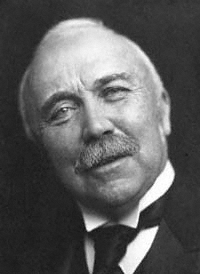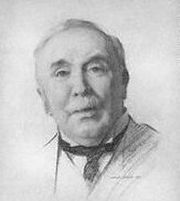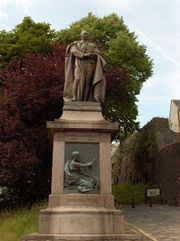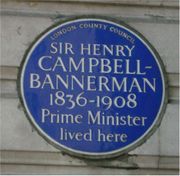Henry Campbell-Bannerman
| The Right Honourable Sir Henry Campbell-Bannerman GCB |
|
 |
|
|
|
|
|---|---|
| In office 5 December 1905 – 3 April 1908 |
|
| Monarch | Edward VII |
| Preceded by | Arthur Balfour |
| Succeeded by | Herbert Henry Asquith |
|
Leader of the Opposition
|
|
| In office 6 February 1899 – 5 December 1905 |
|
| Monarch | Victoria Edward VII |
| Prime Minister | The Marquess of Salisbury Arthur Balfour |
| Preceded by | Sir William Harcourt |
| Succeeded by | Arthur Balfour |
|
Secretary of State for War
|
|
| In office 18 August 1892 – 21 June 1895 |
|
| Prime Minister | William Ewart Gladstone The Earl of Rosebery |
| Preceded by | Edward Stanhope |
| Succeeded by | The Marquess of Lansdowne |
| In office 6 February 1886 – 20 July 1886 |
|
| Prime Minister | William Ewart Gladstone |
| Preceded by | The Earl of Cranbrook |
| Succeeded by | William Henry Smith |
|
Father of the House
|
|
| In office 22 May 1907 – 22 April 1908 |
|
| Prime Minister | Himself Herbert Henry Asquith |
| Preceded by | George Finch |
| Succeeded by | Sir John Kennaway |
|
Member of Parliament
for Stirling Burghs |
|
| In office 1868–1908 |
|
| Preceded by | John Ramsay |
| Succeeded by | Arthur Ponsonby |
|
|
|
| Born | 7 September 1836 Kelvinside, Glasgow, United Kingdom |
| Died | 22 April 1908 (aged 71) 10 Downing Street, Whitehall, London, United Kingdom |
| Nationality | British |
| Political party | Liberal |
| Spouse(s) | Charlotte Campbell-Bannerman |
| Alma mater | University of Glasgow Trinity College, Cambridge, United Kingdom |
| Profession | Merchant |
| Religion | Church of Scotland |
| Signature | |
Sir Henry Campbell-Bannerman, GCB (7 September 1836 – 22 April 1908) was a British Liberal Party statesman who served as Prime Minister of the United Kingdom from 1905 to 1908. No previous First Lord of the Treasury had been officially called "Prime Minister"; this term only came into official usage 5 days after he took office.
Known as CB, he was a firm believer in free trade, Irish Home Rule and the improvement of social conditions. Campbell-Bannerman led the Liberal Party to a landslide victory over the Conservative Party at the 1906 general election. The government he led introduced legislation to ensure trade unions could not be liable for damages incurred during strike action and to provide free school meals for children.
Contents |
Early life
Sir Henry Campbell-Bannerman (1836–1908)[1] was born at Kelvinside House in Glasgow, Scotland as Henry Campbell, the second son and youngest of the six children born to Sir James Campbell of Stracathro (1790–1876) and his wife Janet Bannerman (d. 1873). Sir James Campbell had started work at a young age in the clothing trade in Glasgow, before going into partnership with his brother in 1817 to found J.& W. Campbell & Co., a warehousing, general wholesale and retail drapery business.[2] Sir James was elected as a member of Glasgow Town Council in 1831 and stood as a Conservative candidate for Glasgow constituency in the 1837 and 1841 general elections, before serving as Lord Provost of Glasgow from 1840 to 1843.[3] Henry's older brother, James, was the Conservative Member of Parliament for Glasgow and Aberdeen Universities from 1880 to 1906. In 1871 Henry Campbell became Henry Campbell-Bannerman, the addition of the surname Bannerman being a requirement of the will of his uncle, Henry Bannerman, from whom he inherited the estate of Hunton Court in Kent.
Campbell-Bannerman was educated at the High School of Glasgow (1845–1847), the University of Glasgow (1851), and Trinity College, Cambridge (1854–1858),[4] where he achieved a Third-Class Degree in Classical Tripos. After graduating, he joined the family firm of J.& W. Campbell & Co., based in Glasgow’s Ingram Street. Campbell was made a partner in the firm in 1860. Following his marriage that year to Sarah Charlotte Bruce, Henry and his new bride set up residence at 6 Claremont Gardens in the Park district in the West End of Glasgow. The couple had no children.
Campbell-Bannerman spoke French, German and Italian, and every summer he and his wife spent a couple of months in Europe, usually in France and at the spa town of Marienbad in Bohemia.[5]
Member of Parliament
In April 1868, at the age of thirty-one, Campbell-Bannerman stood as a Liberal candidate in a by-election for the Stirling Burghs constituency, narrowly losing to fellow Liberal John Ramsay. However, at the general election in November of that year, Campbell-Bannerman defeated Ramsay and was elected to the House of Commons as Liberal Member of Parliament for Stirling Burghs — a constituency he was to represent for almost forty years.
Campbell-Bannerman was appointed as Financial Secretary to the War Office in Gladstone's First government in November 1871, serving in this position until 1874, and held it again from 1880 to 1882 in Gladstone's Second government. After serving as Parliamentary and Financial Secretary to the Admiralty between 1882 and 1884, Campbell-Bannerman entered Gladstone's cabinet as Chief Secretary for Ireland in 1884.
In Gladstone's Third (1886) and Fourth (1892–1894) governments and Rosebery's Government (1894–1895) he served as Secretary of State for War, where he persuaded the Duke of Cambridge, the Queen's cousin, to resign as Commander-in-Chief. This earned Campbell-Bannerman a knighthood.
Liberal leader
In 1898 Campbell-Bannerman succeeded Sir William Vernon Harcourt as leader of the Liberals in the House of Commons. The Boer War (1899–1902) split the Liberal party into Imperialist and Pro-Boer camps and Campbell-Bannerman had a difficult time in holding together the strongly divided party, which was defeated in the "khaki election" of 1900. However the Liberal Party was able to unite in its opposition to the Education Act 1902 and the Brussels Sugar Convention of 1902, in which Britain and nine other nations attempted to stabilise world sugar prices by setting up a commission to investigate export bounties and decide on penalties. The Conservative government had threatened countervailing duties and subsidies of West Indian sugar producers as a negotiating tool. The Convention would phase out export bounties and Britain would forbid the importation of subsidised sugar.[6] In a speech to the Cobden Club on 28 November 1902 Campbell-Bannerman denounced the Convention as threatening the sovereignty of Britain:
It means that we abandon our fiscal independence, together with our free-trade ways; that we subside into the tenth part of a Vehmgericht which is to direct us what sugar is to be countervailed, at what rate per cent. we are to countervail it, how much is to be put on for the bounty, and how much for the tariff being in excess of the convention tariff; and this being the established order of things, the British Chancellor of the Exchequer in his robes obeys the orders that he receives from this foreign convention, in which the Britisher is only one out of ten, and the House of Commons humbly submits to the whole transaction. ("Shame.") Sir, of all the insane schemes ever offered to a free country as a boon this is surely the maddest.[7]
However it was Joseph Chamberlain's proposals for Tariff Reform (protectionism) in May 1903 which provided the Liberals with a great cause on which to campaign.[8] Chamberlain's proposals dominated politics through the rest of 1903 up until the general election of 1906. Campbell-Bannerman, like other Liberals, held an unshakable belief in free trade.[9] He proclaimed: "...to dispute Free Trade, after fifty years' experience of it, is like disputing the law of gravitation".[10] On another occasion he explained the Liberals' support for free trade:
We are satisfied that it is right because it gives the freest play to individual energy and initiative and character and the largest liberty both to producer and consumer. ... trade is injured when it is not allowed to follow its natural course, and when it is either hampered or diverted by artificial obstacles. ... We believe in free trade because we believe in the capacity of our countrymen. That at least is why I oppose protection root and branch, veiled and unveiled, one-sided or reciprocal. I oppose it in any form. Besides we have experience of fifty years, during which our prosperity has become the envy of the world.[11]
In 1903 the Liberal Party's chief whip negotiated a pact with Ramsay MacDonald of the Labour Representation Committee to withdraw Liberal candidates in order to help LRC candidates in certain seats. Campbell-Bannerman got on well with Labour leaders and he said in 1903: "We are keenly in sympathy with the representatives of Labour. We have too few of them in the House of Commons".[12] However he was not a socialist.[13] One biographer has written: "He was deeply and genuinely concerned about the plight of the poor and so had readily adopted the rhetoric of progressivism, but he was not a progressive".[14]
The Liberals returned to power in December 1905 when Arthur Balfour resigned as Prime Minister, leaving Campbell-Bannerman to form a minority government. Campbell-Bannerman immediately dissolved Parliament and called a general election. In his first speech as premier on 21 December 1905, Campbell-Bannerman launched the Liberal election campaign, focusing on the traditional Liberal platform of "peace, retrenchment and reform":
Expenditure calls for taxes, and taxes are the plaything of the tariff reformer. Militarism, extravagance, protection are weeds which grow in the same field, and if you want to clear the field for honest cultivation you must root them all out. For my own part, I do not believe that we should have been confronted by the spectre of protection if it had not been for the South African war. ... Depend upon it that in fighting for our open ports and for the cheap food and material upon which the welfare of the people and the prosperity of our commerce depend we are fighting against those powers, privileges, injustices, and monopolies which are unalterably opposed to the triumph of democratic principles.[15]
The Liberals swept to power in a landslide victory.
Prime minister

Henry Campbell-Bannerman was the first man to be given official use of the title ‘Prime Minister’ [16].
Campbell-Bannerman's premiership saw the Entente with Russia in 1907, brought about principally by the Foreign Secretary, Sir Edward Grey. In that same year, Campbell-Bannerman achieved the honour of becoming the Father of the House, the only serving British Prime Minister to do so to date. Nevertheless his health soon took a turn for the worse, and he resigned as Prime Minister on 3 April 1908, to be succeeded by the Chancellor of the Exchequer, Herbert Henry Asquith. Campbell-Bannerman remained in residence at 10 Downing Street in the immediate aftermath of his resignation, and became the only (former) Prime Minister to die there, on 22 April 1908. His last words were "This is not the end of me".[17] Campbell-Bannerman was buried in the churchyard of Meigle Parish Church, Perthshire, near Belmont Castle, his home since 1887. A relatively modest stone plaque set in the exterior wall of the church serves as a memorial.
Legacy

On the day of Campbell-Bannerman's death the flag of the National Liberal Club was lowered to half-mast, the blinds were drawn and his portrait was draped in black as a sign of mourning.[18] John Redmond, the leader of the Irish Nationalist Party, paid tribute to Campbell-Bannerman by saying that "We all feel that Ireland has lost a brave and considerate friend".[18] David Lloyd George said on hearing of Campbell-Bannerman's death:
I think it will be felt by the community as a whole as if they had lost a relative. Certainly those who have been associated with him closely for years will feel a deep sense of personal bereavement. I have never met a great public figure since I have been in politics who so completely won the attachment and affection of the men who came into contact with him. He was not merely admired and respected; he was absolutely loved by us all. I really cannot trust myself to say more. The masses of the people of this country, especially the more unfortunate of them, have lost the best friend they ever had in the high places of the land. His sympathy in all suffering was real, deep, and unaffected. He was truly a great man—a great head and a great heart. He was absolutely the bravest man I ever met in politics. He was entirely free from fear. He was a man of supreme courage. Ireland has certainly lost one of her truest friends, and what is true of Ireland is true of every section of the community of this Empire which has a fight to maintain against powerful foes.[18]
In an uncharacteristically emotional speech on 27 April, the day of Campbell-Bannerman's funeral, his successor Herbert Henry Asquith told the House of Commons:
What was the secret of the hold which in these later days he unquestionably had on the admiration and affection of men of all parties and all creeds? ...he was singularly sensitive to human suffering and wrong doing, delicate and even tender in his sympathies, always disposed to despise victories won in any sphere by mere brute force, an almost passionate lover of peace. And yet we have not seen in our time a man of greater courage—courage not of the defiant or aggressive type, but calm, patient, persistent, indomitable...In politics I think he may be fairly described as an idealist in aim, and an optimist by temperament. Great causes appealed to him. He was not ashamed, even on the verge of old age, to see visions and to dream dreams. He had no misgivings as to the future of democracy. He had a single-minded and unquenchable faith in the unceasing progress and the growing unity of mankind...He never put himself forward, yet no one had greater tenacity of purpose. He was the least cynical of mankind, but no one had a keener eye for the humours and ironies of the political situation. He was a strenuous and uncompromising fighter, a strong Party man, but he harboured no resentments, and was generous to a fault in appreciation of the work of others, whether friends or foes. He met both good and evil fortune with the same unclouded brow, the same unruffled temper, the same unshakable confidence in the justice and righteousness of his cause...He has gone to his rest, and to-day in this House, of which he was the senior and the most honoured Member, we may call a truce in the strife of parties, while we remember together our common loss, and pay our united homage to a gracious and cherished memory—
How happy is he born and taught
That serveth not another's will;
Whose armour is his honest thought,
And simple truth his utmost skill;
This man is freed from servile bands
Of hope to rise or fear to fall;
Lord of himself, though not of lands,
And, having nothing, yet hath all.[19][20]
Robert Smillie, the trade unionist and Labour MP, said that, after Gladstone, Campbell-Bannerman was the greatest man he had ever met.[21]
George Dangerfield said Campbell-Bannerman's death "was like the passing of true Liberalism. Sir Henry had believed in Peace, Retrenchment, and Reform, those amiable deities who presided so complacently over large portions of the Victorian era... And now almost the last true worshipper at those large, equivocal altars lay dead".[22] Campbell-Bannerman held firmly to the Liberal principles of Richard Cobden and William Ewart Gladstone.[14] It was not until Campbell-Bannerman's departure that the doctrines of New Liberalism came to be implemented.[23] Friedrich Hayek said: "Perhaps the government of H. Campbell-Bannerman... should be regarded as the last liberal government of the old type, while under his successor, H. H. Asquith, new experiments in social policy were undertaken which were only doubtfully compatible with the older liberal principles".[24]
There is a blue plaque outside Campbell-Bannerman's house at 6 Grosvenor Place, London SW1. On 6 December 2008 former Liberal Democrat leaders Charles Kennedy and David Steel, now Lord Steel of Aikwood, unveiled a plaque to commemorate Sir Henry at the home in Bath Street, Glasgow. Lord Steel praised his predecessor as Liberal Party leader as an "overlooked radical" whose 1906 landslide victory had paved the way for a succession of reforming governments. "He led the way for the longest period of successful radical government ever, which was continued by Herbert Asquith and David Lloyd George," Lord Steel said.[25]
His bronze bust, sculpted by Paul Raphael Montford is in Westminster Abbey (1908)[26].
Campbell-Bannerman's Government

- Sir Henry Campbell-Bannerman — Prime Minister, First Lord of the Treasury and Leader of the House of Commons
- Lord Loreburn — Lord Chancellor
- Lord Crewe — Lord President of the Council
- Lord Ripon — Lord Privy Seal and Leader of the House of Lords
- Herbert Henry Asquith — Chancellor of the Exchequer
- Herbert Gladstone — Secretary of State for the Home Department
- Sir Edward Grey — Secretary of State for Foreign Affairs
- Lord Elgin — Secretary of State for the Colonies
- Richard Haldane — Secretary of State for War
- John Morley — Secretary of State for India
- Lord Tweedmouth — First Lord of the Admiralty
- David Lloyd George — President of the Board of Trade
- Sir Henry Fowler — Chancellor of the Duchy of Lancaster
- Sir John Sinclair — Secretary for Scotland
- James Bryce — Chief Secretary for Ireland
- John Burns — President of the Local Government Board
- Lord Carrington — President of the Board of Agriculture
- Augustine Birrell — President of the Board of Education
- Sydney Buxton — Postmaster-General
Changes
- January 1907 — Augustine Birrell succeeds Bryce as Irish Secretary. Reginald McKenna succeeds Birrell at the Board of Education.
- March 1907 — Lewis Harcourt, the First Commissioner of Public Works, enters the Cabinet.
Popular culture
- Campbell-Bannerman was the subject of several parody novels based on Alice in Wonderland, such as Caroline Lewis's Clara in Blunderland (1902) and Lost in Blunderland (1903).[27],[28]
Notes
- ↑ The Columbia Encyclopedia, Sixth Edition, 2008, online
- ↑ James MacLehose, Memoirs and Portraits of One Hundred Glasgow Men (Glasgow: James MacLehose and Sons, 1886), p.19.
- ↑ MacLehose, p. 19.
- ↑ Campbell [post Campbell Bannerman], Henry in Venn, J. & J. A., Alumni Cantabrigienses, Cambridge University Press, 10 vols, 1922–1958.
- ↑ Roy Hattersley, Campbell-Bannerman (British Prime Ministers of the 20th century series) (London: Haus Publishing Limited, 2005), .
- ↑ Frank Trentmann, Free Trade Nation. Commerce, Consumption, and Civil Society in Modern Britain (Oxford University Press, 2008), p. 157.
- ↑ The Times (29 November 1902), p. 12.
- ↑ John Wilson, C.B.: A Life of Sir Henry Campbell-Bannerman (London: Constable, 1973), p. 394.
- ↑ Wilson, p. 407.
- ↑ Wilson, p. 410.
- ↑ Wilson, p. 413.
- ↑ Wilson, p. 394.
- ↑ Wilson, p. 506.
- ↑ 14.0 14.1 A. J. A. Morris, ‘Sir Henry Campbell-Bannerman (1836–1908)’, Oxford Dictionary of National Biography, Oxford University Press, Sept 2004; online edn, Jan 2008, accessed 29 March 2009.
- ↑ 'Sir H. Campbell-Bannerman At The Albert-Hall', The Times (22 December 1905), p. 7.
- ↑ Website of British Prime Minister, article on Campbell-Bannerman
- ↑ "Sir Henry Campbell-Bannerman at 10 Downing Street". http://www.pm.gov.uk/output/Page141.asp. Retrieved 2007-01-31.
- ↑ 18.0 18.1 18.2 The Times (23 April 1908), p. 5.
- ↑ http://hansard.millbanksystems.com/commons/1908/apr/27/the-late-prime-minister
- ↑ Wilson, pp. 631-632.
- ↑ Robert Smillie, My Life for Labour (Richmond, 1926), p. 242.
- ↑ George Dangerfield, The Strange Death of Liberal England (Serif, 1997), p. 27.
- ↑ W. H. Greenleaf, The British Political Tradition. Volume Two: The Ideological Heritage (London: Methuen, 1983), p. 150.
- ↑ Friedrich Hayek, New Studies in Philosophy, Politics, Economics and the History of Ideas (Taylor & Francis, 1978), p. 130.
- ↑ "Plaque unveiled to the forgotten Prime Minister, Glasgow Herald, 7 December 2008". http://www.theherald.co.uk/politics/news/display.var.2473356.0.Plaque_unveiled_to_the_forgotten_Prime_Minister_from_Glasgow.php. Retrieved 2008-12-07.
- ↑ "British war memorials · paul montford". http://www.web-mouse.co.uk/remembrance/additionalinfo/britishwarmemorials/hf-ai-bwm-montford.htm. Retrieved 2007-01-31.
- ↑ Sigler, Carolyn, ed. 1997. Alternative Alices: Visions and Revisions of Lewis Carroll's "Alice" Books. Lexington, KY, University Press of Kentucky. Pp. 340-347
- ↑ Dickinson, Evelyn. 1902. "Literary Note and Books of the Month", in United Australia, Vol. II, No. 12, 20 June 1902
References
- A. J. A. Morris, ‘Sir Henry Campbell-Bannerman (1836–1908)’, Oxford Dictionary of National Biography, Oxford University Press, Sept 2004; online edn, Jan 2008, accessed 29 March 2009.
- John Wilson, C. B.: A Life of Sir Henry Campbell-Bannerman (Constable & St Martin's Press, 1973).
Further reading
- Ewen A. Cameron, '‘Maistly Scotch’ Campbell-Bannerman and Liberal Leadership', Journal of Liberal History, Issue 54, Spring 2007.
- Tony Greaves, ‘Sir Henry Campbell-Bannerman’, in Duncan Brack (ed.), Dictionary of Liberal Biography (Politico's, 1998), pp. 69–73.
- J. F. Harris and C. Hazlehurst, ‘Campbell-Bannerman as prime minister’, History, 55 (1970), pp. 360–83.
- Roy Hattersley, Campbell-Bannerman (British Prime Ministers of the 20th century series) (Haus, 2006).
- T. P. O'Connor, Sir Henry Campbell-Bannerman (Hodder & Stoughton, 1908).
- J. A. Spender, The Life of the Right Honourable Sir Henry Campbell-Bannerman GCB (Hodder & Stoughton, 1923).
External links
- Hansard 1803–2005: contributions in Parliament by Henry Campbell Bannerman
- Sir Henry Campbell Bannerman biography from the Liberal Democrat History Group
- More about Henry Campbell-Bannerman on the Downing Street website.
- Archival material relating to Henry Campbell-Bannerman listed at the UK National Register of Archives
| Political offices | ||
|---|---|---|
| Preceded by John Vivian |
Financial Secretary to the War Office 1871 – 1874 |
Succeeded by Frederick Stanley |
| Preceded by Robert Loyd-Lindsay |
Financial Secretary to the War Office 1880 – 1882 |
Succeeded by Sir Arthur Hayter |
| Preceded by George Otto Trevelyan |
Parliamentary Secretary to the Admiralty 1882 – 1884 |
Succeeded by Thomas Brassey |
| Chief Secretary for Ireland 1884 – 1885 |
Succeeded by Sir William Hart Dyke |
|
| Preceded by The Viscount Cranbrook |
Secretary of State for War 1886 |
Succeeded by William Henry Smith |
| Preceded by Edward Stanhope |
Secretary of State for War 1892 – 1895 |
Succeeded by The Marquess of Lansdowne |
| Preceded by Sir William Harcourt |
Leader of the Opposition 1899 – 1905 |
Succeeded by Arthur Balfour |
| Preceded by Arthur Balfour |
Prime Minister of the United Kingdom 5 December 1905 – 3 April 1908 |
Succeeded by Herbert Henry Asquith |
| Leader of the House of Commons 1906 – 1908 |
||
| Parliament of the United Kingdom | ||
| Preceded by John Ramsay |
Member of Parliament for Stirling Burghs 1868 – 1908 |
Succeeded by Arthur Ponsonby |
| Party political offices | ||
| Preceded by Sir William Harcourt |
Leader of the British Liberal Party 1899 – 1908 |
Succeeded by Herbert Henry Asquith |
| Honorary titles | ||
| Preceded by George Henry Finch |
Father of the House 1907 – 1908 |
Succeeded by John Kennaway |
|
||||||||||
|
|||||||
|
|||||||
|
||||||||||||||
.svg.png)